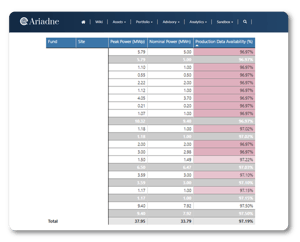
Identify and Solve Communication Problems to Ensure Turnover Across a Portfolio of 1,000 FiT Plants
This case study presents the successful implementation of a solution to automatically identify meter-level data availability issues across a large portfolio of 1,000 small PV plants in Spain operating under a regulated feed-in tariff (FiT) scheme. The implemented solution ensured the rapid identification and communication of data availability issues at the fiscal meter, ensuring their successful resolution and the correct revenue provision to the customer, while optimising operational efficiency and improving return on investment.
CONTEXT
The client, a leading Independent Power Producer (IPP), managed an extensive portfolio of 1,000 photovoltaic plants distributed across Spain. These plants operated under a FiT scheme, in which renewable energy generation was fed into the grid in exchange for fixed tariffs set by the government. The availability of accurate generation data for each fiscal meter was crucial to ensure accurate monitoring and billing, which in turn secured customer revenues.
CHALLENGES
The client faced several challenges related to data availability and revenue provision:
- A variety of equipment and protocols: Photovoltaic plants use a variety of equipment and communication protocols, making standardisation and efficient data collection difficult.
- Data losses: Occasional loss of generation data due to equipment failure or connectivity problems affected the accuracy of monitoring and billing provision.
- Slow identification: Identifying data availability issues at the counter level took excessive time for manual analysis by the management team, affecting the provision of billing and revenue continuity.
SOLUTION
Quintas Analytics proposed and implemented a comprehensive solution that addressed the above challenges:
- Centralised Monitoring Platform: A centralised cloud-based platform was deployed that collected and processed data from all PV plants. This platform used standardised communication protocols to ensure the various devices' interoperability.
- Fault Detection System: A fault detection system was developed that monitored data quality and availability on a daily basis. Deviations were automatically identified, allowing for rapid intervention.
- Process Automation: Processes for reporting identified problems were automated as far as possible. This included automatic alerts in case of unavailability and the generation of regular data availability reports.

RESULTS AND BENEFITS
Implementing the solution had a significant impact on the PV portfolio's operation and profitability:
1. Improved data availability: The centralised platform and rapid fault detection and reporting system drastically reduced downtime, facilitating operational decision making and ensuring the constant availability of accurate information for billing provision.
2. Accurate Revenue: Improved monitoring and billing accuracy ensured that revenues were calculated correctly, avoiding losses due to incorrect or incomplete data.
3. Operational efficiency: Process automation enabled faster problem resolution, reducing downtime and improving overall operational efficiency.
4. Improved profitability: The combination of accurate data, reduced downtime and more efficient operation contributed to an overall improvement in the profitability of the portfolio.
CONCLUSIONS
The implementation of this end-to-end solution proved to be highly successful in securing the billing for a portfolio of 1,000 PV plants under a FiT scheme. The combination of advanced monitoring technologies, fast fault detection and process automation not only addressed data availability issues, but also ensured effective revenue provision, optimised operational efficiency and improved project profitability. This solution also allows new assets to be added to the portfolio at no additional cost under the same management scheme.
